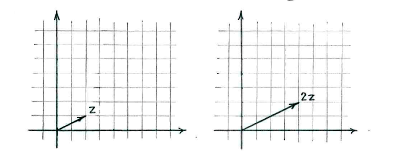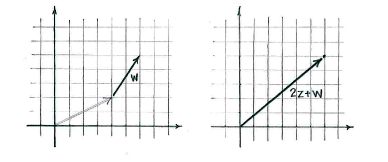Solution 3.2:1c
From Förberedande kurs i matematik 2
(Difference between revisions)
m |
|||
| (3 intermediate revisions not shown.) | |||
| Line 1: | Line 1: | ||
| - | + | By calculation, we obtain | |
| - | + | ||
| - | + | ||
| + | {{Displayed math||<math>2z+w = 2(2+i)+(2+3i) = 2\cdot 2 + 2 + (2+3)i = 6+5i</math>}} | ||
| - | + | and we can mark this point on the complex plane. | |
| - | [[ | + | If we treat <math>z</math> and <math>w</math> as vectors, then <math>2z</math> is the vector which has the same direction as <math>z</math>, but is twice as long. |
| + | |||
| + | [[Image:3_2_1_c1.gif|center]] | ||
| + | |||
| + | We add <math>w</math> to this vector and get <math>2z+w</math>. | ||
| + | |||
| + | [[Image:3_2_1_c2.gif|center]] | ||
Current revision
By calculation, we obtain
| \displaystyle 2z+w = 2(2+i)+(2+3i) = 2\cdot 2 + 2 + (2+3)i = 6+5i |
and we can mark this point on the complex plane.
If we treat \displaystyle z and \displaystyle w as vectors, then \displaystyle 2z is the vector which has the same direction as \displaystyle z, but is twice as long.
We add \displaystyle w to this vector and get \displaystyle 2z+w.


